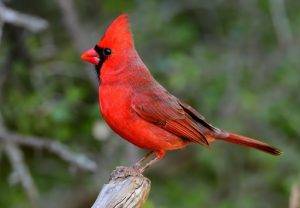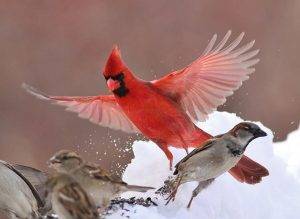Birds, with their diverse and captivating nature, have long been a source of fascination for nature enthusiasts, scientists, and casual observers alike. From the smallest hummingbird to the mighty eagle, each species boasts unique characteristics, behaviors, and distinctive diets.
In this exploration, we’ll delve into the captivating world of North Carolina’s state bird, uncovering its significance, characteristics, and role in the rich tapestry of the state’s biodiversity.
The Northern Cardinal: North Carolina’s Feathered Ambassador
The Northern Cardinal (Cardinalis cardinalis) stands proudly as the state bird of North Carolina, symbolizing the vibrant beauty of the region’s wildlife. Known for its stunning red plumage and melodic songs, the Northern Cardinal is a year-round resident in the state, adding a splash of color to both urban landscapes and rural woodlands.
A Symphony of Red: The Cardinal’s Distinctive Plumage
One cannot discuss the Northern Cardinal without marveling at its striking appearance. The male cardinal, with its brilliant crimson feathers, is a sight to behold against the backdrop of green foliage or a blanket of snow. In contrast, the female sports a more muted combination of brown and red, showcasing a subtle elegance that complements the male’s flamboyance.
The cardinal’s vibrant plumage is not merely for aesthetic pleasure; it serves a purpose in the bird’s life. The bright red coloration plays a crucial role in courtship rituals, with males using their striking appearance to attract potential mates. Additionally, the cardinal’s plumage provides effective camouflage, aiding in its survival in a variety of habitats.
Melodious Tunes: The Cardinal’s Song
Beyond its visual allure, the Northern Cardinal is renowned for its enchanting songs. The male cardinal, in particular, is a prolific singer, filling the air with a variety of musical phrases. These songs serve multiple purposes, including territorial marking, communication with a mate, and warning calls in the presence of potential threats.
Interestingly, cardinals are known to be one of the few bird species capable of recognizing their own reflections. When faced with a mirror, a cardinal may interpret its own reflection as an intruder, leading to spirited attempts to drive away the perceived rival.
Dietary Preferences: Unraveling the Cardinal’s Culinary Choices
While the Northern Cardinal’s dietary habits may not be as diverse as its visual and vocal characteristics, understanding its feeding preferences is key to appreciating its role in North Carolina’s ecosystems. Cardinals are primarily granivores, meaning their diet revolves around seeds. Their sturdy, conical beaks are well-suited for cracking open seeds, and they often feed on a variety of plants, including sunflower seeds, millet, and safflower seeds.
In addition to seeds, Northern Cardinals supplement their diet with insects, fruits, and berries. During the breeding season, the protein-rich insects provide essential nutrients for growing chicks. This omnivorous aspect of their diet highlights their adaptability and ability to thrive in a range of environments.
Northern Cardinals play an important ecological role beyond their dietary habits. As seed consumers, they help regulate plant populations by dispersing seeds throughout their habitats. Additionally, their consumption of insects can help control pest populations, benefiting both plants and other animals in the ecosystem. The fruits and berries they consume contribute to seed dispersal for various plant species, aiding in the regeneration of forests and other habitats.
Furthermore, Northern Cardinals are known to be territorial during the breeding season, defending their feeding territories vigorously. This behavior can influence the distribution and behavior of other bird species in their vicinity, creating intricate ecological interactions within their communities.
Understanding the Northern Cardinal’s dietary preferences and its broader ecological role sheds light on the intricate web of interactions that sustain North Carolina’s ecosystems. By studying and appreciating these aspects of their behavior, we can better conserve and manage habitats to support not only Cardinals but also the diverse array of species that depend on them.
Conservation Status: Sustaining the Cardinal’s Presence in North Carolina
While the Northern Cardinal is not currently listed as a species of concern, understanding the factors contributing to its well-being is crucial for maintaining healthy populations. Urbanization, habitat loss, and climate change can all impact the availability of suitable habitats and food sources for cardinals.
Urbanization poses a significant threat to Northern Cardinal populations as it leads to the destruction and fragmentation of their natural habitats. The expansion of cities and suburbs often results in the loss of trees and shrubs, which are essential for nesting, foraging, and shelter. Additionally, urban areas may introduce new hazards such as collisions with buildings and vehicles, predation by domestic pets, and exposure to pollutants.
Habitat loss, driven by various human activities including agriculture, logging, and development, also poses a significant challenge to the Northern Cardinal’s well-being. As forests are cleared and fragmented, the interconnected network of habitats essential for cardinals becomes disrupted, leading to decreased breeding success and survival rates.
Climate change further exacerbates these challenges by altering temperature and precipitation patterns, disrupting seasonal cues critical for breeding, migration, and food availability. Shifts in climate can also lead to changes in the distribution of plant and insect species, potentially affecting the cardinal’s diet and nesting opportunities.
Conservation efforts in North Carolina focus on preserving diverse ecosystems, providing bird-friendly landscapes, and raising awareness about the importance of protecting native species. Through habitat restoration and management initiatives, organizations work to create and maintain suitable environments for Northern Cardinals and other wildlife. This includes planting native vegetation, establishing wildlife corridors, and implementing sustainable land-use practices.
Engagement with the community is also essential for effective conservation. Birdwatching and citizen science initiatives not only provide opportunities for people to connect with nature but also play a crucial role in monitoring cardinal populations and understanding their behavior. By participating in bird surveys, nest box monitoring programs, and habitat restoration projects, citizens contribute valuable data to conservation research, helping to inform management decisions and prioritize conservation actions.
The Cardinal in Culture: Beyond Biology
The Northern Cardinal’s cultural and symbolic significance in North Carolina transcends mere representation in official symbols; it has woven itself into the fabric of the state’s identity. Renowned for its vibrant plumage and melodious song, the cardinal has become an emblem of vitality, resilience, and beauty in the eyes of North Carolinians.
In addition to its official status, the cardinal has inspired countless artistic endeavors throughout the state’s history. Painters have captured its brilliant red feathers against lush green backdrops, while sculptors have immortalized its graceful form in bronze and stone. Poets and writers have penned verses and stories that evoke the cardinal’s presence, weaving its symbolism into narratives of love, courage, and perseverance.
Furthermore, the cardinal holds a place of honor in the folklore and traditions of North Carolina’s diverse communities. From Native American legends to Southern folktales, the bird is often portrayed as a messenger of good fortune or a guardian spirit watching over the land. Its distinctive appearance and behavior have sparked superstitions and customs that endure to this day, enriching the cultural tapestry of the state.
As North Carolina continues to evolve, the Northern Cardinal remains a steadfast symbol of its natural heritage and creative spirit. Whether perched on a branch in a forest glade or immortalized in paint and verse, it serves as a timeless reminder of the intrinsic connection between humanity and the natural world.
Northern Cardinal Fun Facts: Trivia to Delight Bird Enthusiasts
- State Symbol: The Northern Cardinal was designated as the official state bird of North Carolina in 1943.
- Year-Round Residents: Unlike some migratory birds, Northern Cardinals are present in North Carolina throughout the year, making them a familiar sight in all seasons.
- Feathered Pairs: Northern Cardinals are known for their monogamous mating behavior, often forming pairs that remain together year-round.
- Territorial Songs: Male cardinals are territorial and use their songs to attract mates and establish and defend their territory.
- Urban Adaptability: Northern Cardinals have demonstrated a remarkable ability to adapt to urban environments, thriving in gardens, parks, and suburban landscapes.
Related Post:
Unlocking the Mysteries of Duck Egg Laying: How Often Do Ducks Lay Eggs?
When Do Ducks Start Quacking? Unraveling the Quack-tastic Mystery
Exploring the Fascinating World of Frigate Birds: Masters of the Skies
In the vast tapestry of North Carolina’s natural heritage, the Northern Cardinal is a symbol of beauty, adaptability, and resilience. Its vibrant plumage, melodic songs, and distinctive presence make it a beloved resident, capturing the imaginations of residents and visitors alike.
As we continue to appreciate and celebrate North Carolina’s state bird, it’s essential to recognize the interconnectedness of its existence with the broader ecosystem. Conservation efforts, habitat preservation, and fostering an appreciation for the state’s biodiversity are integral to ensuring that the Northern Cardinal continues to enchant generations to come.
So, the next time you catch a glimpse of a cardinal perched on a branch or hear its delightful song echoing through the air, take a moment to reflect on the intricate beauty of North Carolina’s avian ambassador and the importance of safeguarding the natural wonders that make the state genuinely extraordinary.




